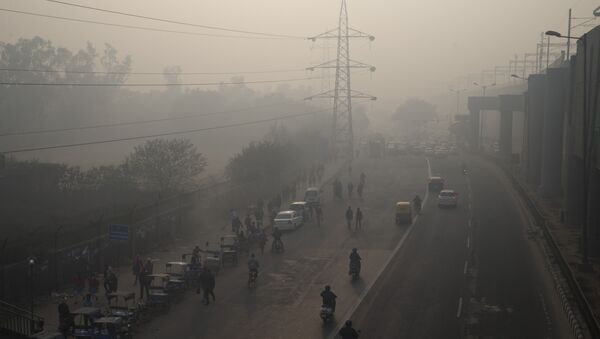New Delhi (Sputnik): The Indian government has started the installation of cost-effective homegrown air filters on the roadside of the national capital Delhi, which has been witnessing the accumulation of killer smog during winters over the last few years.
READ MORE: New Delhi Arms Itself With Anti-Smog Guns to Combat Lethal Pollution
The installation of the devices started at two heavy traffic junctions — ITO and Mubarka Chowk. In the next 20 days, the device, named WAYU (Wind Augmentation Purifying Unit), will be installed in at least 54 places in India's national capital.
Union Minister @drharshvardhan inaugurates the air pollution control device #WAYU — Wind Augmentation and Purifying Unit, at Bahadur Shah Zafar Marg, ITO Intersection, New Delhi pic.twitter.com/tJQWMf7Yn4
— PIB India (@PIB_India) September 25, 2018
"We are in the process of developing a bigger version of WAYU which can purify the air in an area of 10,000-meter square and also the designs of future WAYU devices will have even better aesthetics and can be deployed in bus shelters," Harsh Vardhan, India's Science and Technology minister, said.
Before the onset of winter, #NEERI will install 54 devices at different pollution hotspots in Delhi. #WAYU is the most cost-effective one at Rs. 60000 with a maint. cost of Rs. 1500/month, while it does more things than similar devices available in the world. @PMOIndia, @CSIR_IND pic.twitter.com/HYpa9VcWtQ
— Dr. Harsh Vardhan (@drharshvardhan) September 25, 2018
The indigenous device works on two principles, mainly wind generation for dilution of air pollutants and active pollutants removal. The device has filters for particulate matter removal and activated carbon (charcoal) and UV lamps for poisonous gas removal, such as volatile organic compounds and carbon monoxide. The device has one fan and a filter for sucking and removing particulate matter.
READ MORE: Delhi’s Deadly Air Likely to Cost Dear to Indian Economy
Last year, India's apex court appointed an Environment Pollution (Prevention and Control) Authority to draw out a graded response action plan for taking emergency measures in the national capital to combat and counter pollution spikes — a concept borrowed from Beijing.



